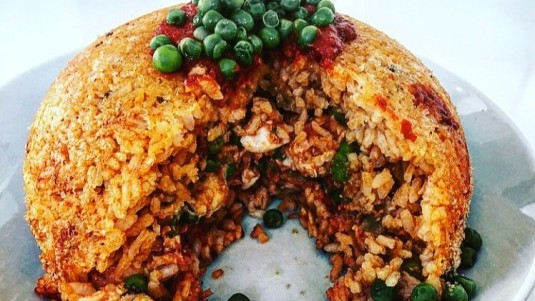Rice sartù

A rice sartù is a rich and elaborated timbale the recipe for which dates back to the 18th century. It was created by refined French chefs – monsù– to satisfy the culinary desires of Maria Carolina of Austria, the wife of King Ferdinand of the Two Sicilies. The dish mergers elements of Neapolitan and French cuisine the result of which is a culinary masterpiece. Its original name in French was ‘sor tout,’ which roughly translates ‘cover everything’, and with time it evolved into sartù and referred to the preparation that covers its filling.
Together with ragù, genovese and the baked macaroni ring, sartù is one of the most-loved Sunday dishes in Neapolitan cuisine.
Ingredients for 6/8 people:
600g semi-fine rice, breadcrumbs as needed and 2 eggs.
For the filling : 200g mozzarella, 4 hard-boiled eggs, 200g steamed peas, 200g Parmigiano Reggiano and 300g fried hazelnut-sized meatballs.
For the ragù : 100g tomato paste, 1.5l strained tomato sauce, 100g onions, 500g pork spare ribs, 300g chopped sausage, 1dl extra-virgin olive oil, 1 glass red wine and salt as needed.
Directions :
Prepare the ragù by sautéing finely sliced onions for a few minutes at a medium heat before adding the spare ribs and sausage. Pour the wine over the meat and raise the heat for a couple of minutes. Then add the tomato paste and sauce, salt and a ladle of water. Lower the heat and simmer for four hours.
Boil the rice in salted water until it is still very ‘al dente’ and then drain and rinse in cold water to stop the cooking process. Add in a ladle of ragù, 3 tablespoons of Parmigiano and the beaten eggs and mix.
In the meantime, butter all the surfaces of a 23cm-high baking mold and sprinkle breadcrumbs over the butter.
Prepare the filling by cutting the mozzarella, hard-boiled eggs and the sausage from the ragù into pieces and then add them to a bowl with the peas and the meatballs together with the rest of the Parmigiano and a ladle of ragù. Mix together and keep aside.
Line the sides and bottom of the butter baking mold with rice to a thickness of around 2cm and then put in the filling and cover with a layer of rice.
Bake the sartù at 200°C for around 30 minutes, until the surface is a golden-brown and slightly burned.
Let the sartù cool for 10 minutes and then turn the mold over and empty onto a serving platter. Serve covered with the remaining ragù.
Wine to pair:
Valpolicella Doc Bertani

The red grapes from the Verona area, especially Corvina, express the warmth, strength and concentration of the fruits of this land: from the Valpolicella Classica area, the characteristic notes of fresh fruits, cherry in particular, from Valpolicella Valpantena the spicy notes and the silky tannins. A combination of colours and flavours that offer extraordinary elegant and pleasant sensations. Intense hints of redcurrants, plums, raspberries, sour cherries balanced by spicy notes reminiscent of pepper and cinnamon. On the palate it is approachable, fresh and pleasant, thanks to good balance between acidity, savoury notes and richness of flavour.
Production area: Tenuta Novare vineyards, in the heart of the Valpolicella Classica area, and from the Valpantena vineyards, near the municipality of Grezzana. The soils are calcareous-marl and calcareous-clay, rich in iron.
Grape varieties: 80% Corvina Veronese and 20% Rondinella. The vines are vertical-trellised, with Guyot pruning and a planting density of 5000 plants/ha.
Winemaking method: The harvest is done by hand in the last ten days in September. After destemming and crushing, the must is fermented in wide and shallow steel tanks, ideal for increasing contact between skins and must and for limiting mechanical intervention. Ageing in concrete vats lined with glass bricks in the underground part of the cellar for about 8 months and then in the bottle for at least 3 months.
Serving temperature: 16-18°C.
Food pairing: it is excellent with strong-flavoured pasta dishes, grilled, roast and stewed meat and medium-matured cheese.

 Italiano
Italiano







